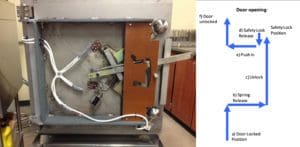Priorclaves are Ideal Education Autoclaves Because We Put Safety First
By: Priorclave
Category: Lab Autoclaves

Many students are terrified of their lab’s autoclaves—and not without cause: autoclave accidents are much more commonplace in North America than elsewhere. Sadly, there’s an argument to be made that these “accidents” are no accident:
Autoclaves designed and built to US regulatory standards lack many common sense safety features built into autoclaves sold in the UK and EU.
We have written before about how these autoclave lab accidents happen. The difference in regulation is a big part of the “Why?”
In the United States we do not set a regulatory standard for the temperature an autoclave chamber must reach prior to opening. That means that a lab tech opening an autoclave built to US regulatory specifications is able to open the door regardless of how cool—or, much more concerning, how HOT—the chamber or load inside might be. By US standards, your lab technicians may easily open chambers that still contain superheated steam—or worse, “bottle bombs” ready to burst. Steam alone can instantly cause severe burns on the face and hands. Sealed glassware abruptly exposed to sudden temperature drops can explode, sending hot liquids, steam, and broken glass flying all over your lab.
Every Priorclave is Built to Safer EU Standards
CEO Barbra Wells recalls: “I was visiting a lab on a sales call. When I arrived, first responders were there for an autoclave accident that had seriously injured at least one faculty member. This wasn’t a student, but an experienced technician! I learned later that it was attributed to ‘user error’ because they had opened the door prematurely, while the load was still hot. But that’s a fine line. It’s really a design error. So many US-built autoclaves can be opened before it’s safe. It shouldn’t be possible for user error to result in that sort of injury.”
With a Priorclave, such an “accident” is not possible. We build Priorclaves to stringent European Pressure Equipment Directive. They cannot be opened prior to cooling.
As Priorclave’s Managing Director Tony Collins explains,
“The energy stored in an autoclave at operating temperatures, even at relatively low pressures, is immense. For that reason autoclaves are subject to tight regulation of their construction and operation in the UK and European Union. Sadly, this is not the case in the United States, which we strenuously disagree with. In contrast to some other manufacturers, we do not produce these less safe US-compliant models, but instead ship every Priorclave with the same EU-mandated safeguards.”
We’re Annoying You on Purpose—You’re Welcome
It’s true: Priorclaves have a unique door latch that sometimes frustrates new users. But with use, most lab technicians and leaders realise that it is a smart design. 
Firstly, the door and larch are extremely durable, even with little maintenance. Secondly, the unique priorclave latch is capable of one-handed operation, for improved lab accessibility. But most importantly, this door is extremely safe. The door latch functions as a mechanical fail safe to our electronic thermal lock system. The door cannot and will not freely open while the chamber remains pressurised.
As many have found, it is also nearly impossible to open the door at all without training—and in a teaching environment, that’s exactly what you want. Because if someone hasn’t had even that minimal amount of supervised training, you definitely don’t want them wandering around popping open autoclave doors.
These injuries don’t have to happen, especially in teaching and learning environments. At Priorclave, we’re building our autoclaves so that, even when user error occurs, the operator’s safety remains top priority. If you’re setting up priorclave stations in your lab and want to ensure a superior level of safety for staff and students, get in touch with us at Priorclave.

